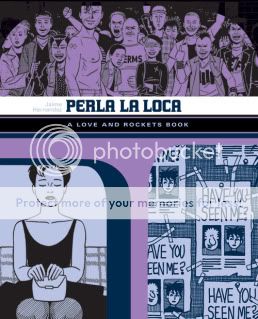Perla La Loca
(Love and Rockets Library: Locas, Book Three)
Jaime Hernandez, writer/artist
Fantagraphics, 2007
288 pages
$16.95
Things take a turn for the unpleasant in this volume. I don’t mean sad or heartwrenching–they’ve already done that; I mean unpleasant. Taking a look that old negative review of Locas I wrote, I’m pretty sure this is where Jaime lost me completely the first time around. Ray can’t get it together enough to hang on to Danita, and she skips town. Doyle can’t get it together enough to hang onto himself, and he skips town. Penny’s pretty much settled into the unfulfilling life of being Mrs. H.R. Costigan, theoretically banging out kids with her manservants as a way of passing the time. Maggie brings disaster everywhere she goes (though she means well, at least). And Hopey! With the image of her smoking on the toilet while pregnant still fresh in our minds from the last volume, she she falls in with a bunch of people just as glib and nasty as she is–only as it turns out they’re even worse, and several people are beaten nearly to death for her to learn that lesson. Love and sex were never quite “carefree” in the Locas stories–people pined and got hurt at least as often as they had a great time or did really romantic and loving things–but in this volume the sex gets downright seedy, transactional at best and joylessly fetishistic at worst. It’s a book about creeps.
Fortunately I’m now able to accept that. I don’t know what the hell came over me when I wrote that old review, to be honest. In what world does making art about creeps necessarily constitute and endorsement of being a creep? Upon this re-read it’s quite clear that Jaime is in no way rah-rah’ing Hopey’s behavior, which he consistently depicts as show-offy, designed for audience consumption. I mean, she elbows a crowd of prostitutes out of the way to go down on someone, and out-hipsters everyone by declaring an aging TV star’s pedo-fetish lifestyle: “I think it’s super-cool.” No one must ever accuse Hopey Glass of being in any way square! As we see from flashbacks to her as a squirmy little girl refusing to sit still for a photographer, and as a teenage asshole subjecting her loyal friend Daffy to a humiliating encounter with an S&M whackjob, she thrives on other people’s disapproval. She lives to be a magnificent bastard. Only this time around, the bastardry comes back to bite her.
Maggie is a much nicer person and therefore her story is a lot nicer, but she’s now getting less out of her basket-case love life than ever. Far away from anyone with whom she ever had a good thing going–Hopey, Ray, Casey, even Speedy or Race–she falls into a pattern of breaking the hearts of the people who are interested in her and screwing up the lives of the friends who aren’t. Her chaos has become contagious. And her now-rare moments of sexual intimacy use cash as a buffer. “The real secret is that I really didn’t feel bad about doing it,” she confides, “Like it was no big deal.” What a relief that must be to her, since “everything is a BIG DEAL” is basically her life story!
So what conclusions are we to draw from all this? It’s taken me a while, but I’ve come to the conclusion that drawing a conclusion is the wrong thing to do. There’s not some message being sent here about, I dunno, punk or fluid sexuality or sex work, which are sort of the common threads of the two big stories here–the Hopey-centric “Wigwam Bam” and the Maggie-centric “Chester Square”-to-“Bob Richardson” suite. The message, I think, is simply to be found in the fact that there are two big, separate Maggie and Hopey stories here. They’re not symbols, they’re people. Here you have two people who were once so inseparable and similar that their friends and enemies called them The Incest Twins, and now they’re finally, really living apart. When two people have formed their identities in such an inextricable way–in Maggie’s case it’s so profound that it’s the exception that proves the rule of her sexual orientation itself–what happens when you extricate them? Well, they make some really shitty life choices, they have a hard time figuring out who they are, they hurt some friends, they get some other friends hurt, they make still other friends wonder if they were really such great friends to begin with, they hurt themselves, and they start–barely–to move on. All in the hands of the kind of artist who can draw characters to have family resemblances or to look enough alike that other characters can’t tell them apart, but we the readers can even while seeing those resemblances. Story made possible by sheer chops. Damn.
Tags: comics, comics reviews, Comics Time, Jaime Hernandez, Los Bros Hernandez, Love and Rockets, LOVE AND ROCKTOBER, reviews


2 Responses to LOVE AND ROCKTOBER | Comics Time: Perla La Loca